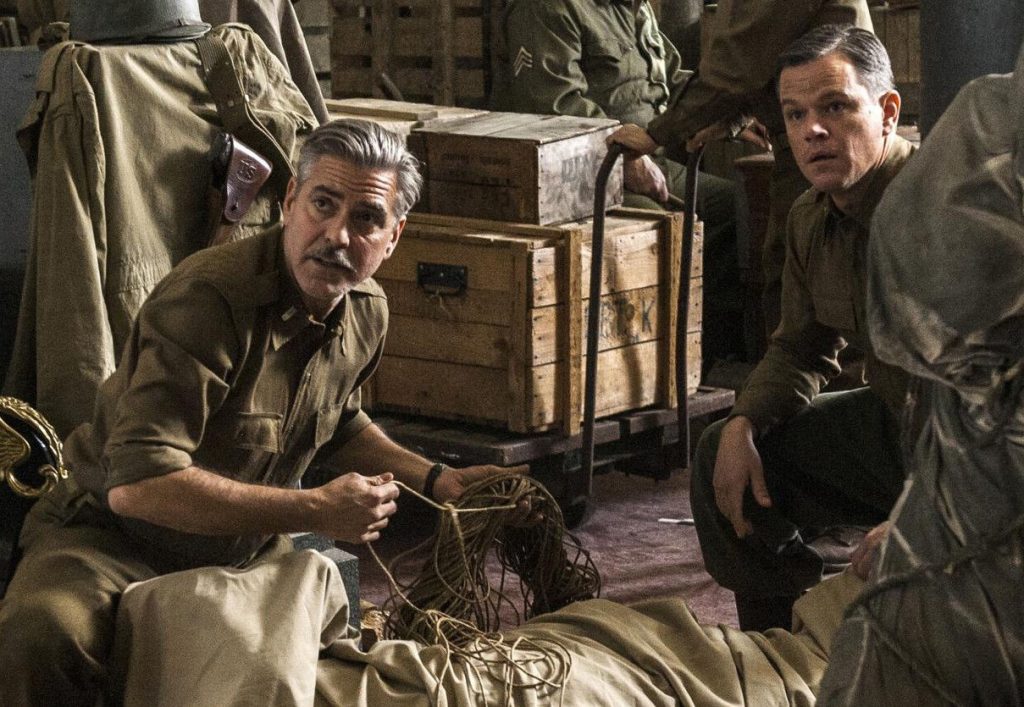When is the last time a Hollywood movie made you feel proud to be a Catholic? Maybe “The Song of Bernadette,” from way in the 1940s, or “The Sound of Music” in 1965?
Since the start of the current movie ratings system, which in 1968 replaced the Catholic Church’s seal of approval, the Catholic Church in America hasn’t had a lot of pull with Hollywood. Since then, there has been a noticeable shift from positive portrayals of Catholic clergy to priests and nuns often being portrayed as evil or foolish, or being completely nonexistent in TV shows and films.
But the new movie “The Monuments Men” offers a refreshing and touching portrait of the church in a positive light, as it tells the story of a special team of art experts who were assembled under the U.S. Army to track down priceless works of art that had been stolen by the Nazis.
The Nazis had hoped to place these masterpieces into a giant museum dedicated to Hitler, with the goal of crushing the spirits of those countries which lost their finest art and making Hitler the possessor of the greatest collection in world history.
Yet thanks to the daring efforts of these forces who were affectionately dubbed “the monuments men,” most of the art was recaptured and restored to their rightful homes across Europe. Many of these works were taken from private collections in Jewish homes, but the movie makes it clear that the works that most concerned our brave and heroic forces were the ones that were central to Catholicism: Michelangelo’s “Madonna and Child” and the altar centerpiece from the Cathedral at Ghent.
Hollywood power player George Clooney not only stars as the leader of the heroic team but co-wrote, produced and directed the film. Clooney has never seemed to express his sense of spirituality in public before, but he nonetheless offers a stirring homage to the power of the Church, faith and art in this film.
In the speech his character, Frank Stokes, gives to President Franklin Roosevelt seeking authorization to save the art, he notes that modern warfare had become so destructive that the randomness of air strikes and firefights was coming dangerously close to destroying such works as “The Last Supper” by Leonardo DaVinci. And he notes that when art is destroyed, so is mankind’s sense of a higher self and a higher purpose. Saving the art was key to saving the world’s sense of humanity.
Later, a British member of the Monuments Men sneaks into a church where monks are frantically trying to hide the “Madonna and Child” sculpture from encroaching Nazi forces and is asked if he is Catholic. Overcome by the urgency of the moment, he says “I am tonight,” before proudly taking a bullet from the Nazis in his attempt to defend the statue from being stolen.
In fact, the man is not actually Catholic. But standing in awe of the statue and the power it holds through its depiction of the Christ Child and Mary, he represents a point that Clooney’s Stokes very clearly makes: If these artworks are lost to the hands of the Nazis, the world as a whole will suffer. These works of art were not just French, Belgian or Italian treasures but all of mankind’s because they are inspired by God.
Clooney and his team (a staggering cast that includes Matt Damon, Bill Murray and Cate Blanchett) find themselves not only up against the Nazis but against the confusion and indifference of some American officers who don’t respect their efforts. But as Clooney stands up to these ignorant attitudes and tries to buck up his men’s spirits, he movingly educates the audience as well on how tragic it would be if the world lost its greatest cultural achievements.
Such profoundly noble motivations underscore Clooney’s own ambitions with this film, which eschews the silly yet fun, manic style of Nicolas Cage’s “National Treasure” movies in favor of a more thoughtful yet still entertaining story that has a deeper, more philosophical consideration of the art being saved.
This unabashedly patriotic, old-fashioned movie may surprise those who think that liberal Hollywood stars are unlikely sources for a movie so respectful of faith and the powerful art it inspires. But perhaps that is just another example of how the Catholic Church’s best art is inspiring to all types of people. Thank Clooney for creating this monument to a team of forgotten men.
Carl Kozlowski is co-founder of www.radiotitans.com, and host of its shows "The Koz Effect" and "Kozversations."
The USCCB Catholic News Service review notes that this film contains some combat violence with brief gore, about a half-dozen uses of profanity and a few crude and crass terms. The CNS classification is A-III (adults). The Motion Picture Association of America rating is PG-13 (parents strongly cautioned. Some material may be inappropriate for children under 13).

